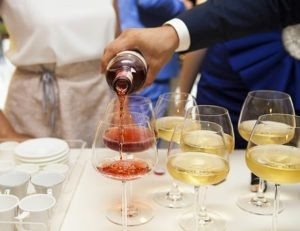HOW TO CHOOSE A GOOD BOTTLE OF WINE

So, you’re standing in a wine shop with a huge selection of wines in front of you, or hosting a business lunch with just a few minutes to choose a good bottle of wine. Dilemma! You ask yourself in a panic, “where do I even start?”
I’m going to use this post to waylay your fears, by providing you with wine decision shortcuts. I’m going local with my first insights which should help you when standing in a wine shop faced with shelves of options.
Shops will either a) place the more expensive bottles on the top shelf and work down towards the bottom where the least expensive bottles are, or b) place the popular and casual drinking bottles at head height (middle shelves) and fill the other shelves with other higher value options.
In Green Acres, we follow the latter method as the majority of our wine browsers are just looking for something nice to take home for a casual dinner. So, if you are looking for a treat or a gift, have a look at the bottles above and below the middle shelves otherwise look straight ahead for our casual recommendations.
Just a few more insights.
It’s a really good idea to make a friend at your local wine retailer. Small local retailers love talking about wine and are there to help you. Ask them for help. And by the way, never purchase a bottle based on its label only. Some large producers may spend more on label design and bottling than the contents.
It’s always useful to be aware of how the shop’s wines are displayed (by country/regions etc.) as it can help you cut down the options you don’t want. And while you’re at it, ask about the neighbouring regions to popular vineyards, you’ll be surprised with what you might discover at great prices.

SIX TIPS ON PURCHASING A GOOD BOTTLE OF WINE
For some people, buying a bottle (or a case) of wine is an exciting event. Contrary to popular opinion, the adrenaline rush for the savvy wine buyer can be the excitement that stems from the unknown i.e. quality, grape, region, country etc.
For the non-savvy buyer, however, it can be simply the choice between whether they feel like a white or a red or trying to remember whether they liked a cabernet or a merlot. Whichever you are, here are a few tips that might help you choose a good bottle of wine that you will enjoy.
– Download a free wine app to your smartphone. When your tasting your own bottle – take a picture of the label and see how others are describing their experience. The Vivino app appears to be very popular.
– Learn some basic wine styles and determine what you like. Try and discover why you like a particular style be it, full-bodied, dry, sweet or sparkling.
– Get to know just a few pairings with food, especially for the wine styles that you like. When it comes to food it will be about the flavours of the wine.
– If there is a tasting (or wine dinner) in your local shop go down and do some tasting! They usually have an expert there explaining about the wines so this can be a cheap and cheerful way to learn about wines.
– Most bottles will indicate a lot of insights about the wine on its label. Learn how to read them, it is quite simple. In fact, I think I’ll cover this topic in a forthcoming blog post just to prove how simple it is.
– A little understanding about how to store a wine can go a long way. The short version is to avoid wide temperature changes, heavy shaking, and sunshine.

NOBODY AROUND TO HELP YOU CHOOSE A GOOD BOTTLE OF WINE?
We’ve all been there. We get an invitation to a party and need to bring a bottle of wine with us. Now I’ll be the first to admit that the world of wine doesn’t always help itself by using complicated jargon (see my recent post on wine jargon) which makes a mere mortal burst into a sweat every time they have to make sure the bottle chosen is a good one.
Also, hey – who wants to spend their hard-earned cash on wine blindly only to taste disappointment and regret.
As I alluded to earlier the worst thing you can do is to choose a wine based on its label. It might look like it fits what you think you would like but it just might end in tears. Remember, for every carefully crafted wine, there will be many bottles of bulk, commercial, lifeless liquids to struggle through.
So, to help you select an appropriate wine for an occasion that will be tasty, Donal Morris and myself have come up with 5 pointers:
KEEP AN EYE ON THE PRICE.
Interestingly, in a restaurant, it is the second cheapest wine on a menu that most people order. They do this to avoid looking cheap – I’m going to say to you that very often the house red/white is the best value as good restaurants will not risk serving a bad house wine.
The one caveat I have is that the high rate of taxes in Ireland means the original cost of the bottle is quite a bit lower than what you pay. My advice is to stick to the mid-range bottles that are better value and quality.
KNOW YOUR COUNTRIES.
It’s always good to have some idea of which countries are best at what they produce. Just like you wouldn’t expect to find the best Irish stew in Madrid, you wouldn’t expect to find a wine style that suits the Italian climate to be better in South Africa. Here are a few thoughts to ponder:
- France has great complex, aged red wines
- Australia, Chile and USA have good fruity wines
- Portugal and Alsace have dry white wines
- Italy has light bodied, easy drinking reds
- Hungary has great sweet wines
I fully appreciate many regions/countries produce many styles of wine but my example above is to give you a sense of what different countries are best at.
You would expect to get a better Irish stew in Dublin rather than Madrid, wouldn’t you? Learn about your wine countries.
DON’T JUST OPT FOR THE WELL-KNOWN WINES.
Very often the big brands you see on the TV aren’t designed to engage you emotionally. They are crafted to appeal to the widest possible audience and offered at low prices. The bottles are easily recognised due to large commercial campaigns and may have quirky names and labels to attract the purchaser.
I am not saying that these won’t be pleasant to drink but, the conglomerate’s mission is to use high-yielding vines to get the most profit from the grape. In my opinion, they lack the personal touch on the smaller independent producers who put their soul into their annual vintage. The results are more interesting and memorable.
DELVE DEEPER INTO THE REGIONS.
Especially in the old world wines from say France, Spain, and Italy – producers get to represent their region by meeting certain rules/guidelines/conditions that set them apart from others. So, when looking at a label, if it just says France as opposed to having a region, a sub-region, a village or a producers name – will make a big difference to quality and taste.
HAVE A BASIC UNDERSTANDING OF FOOD PAIRING.
Much has been written about the complexity of pairing food with wine. Yes, it can be tricky as both the food and the wine will have a range of flavours, not just one (i.e. the red with meat / white with fish myth). The experts certainly do understand the nuances of perfect pairings but for the non-experts, I want to suggest one basic rule.
Match the complexity of wine with the food: complex wine for complex food, simple wine for simple food. So, a light dish with delicate flavours will pair best with a light white wine or light-bodied red. If the dish has a deeper flavour then chose a wine that will stand up to it – a heavy bodied wine.
If in doubt, match the origin of wine with the origin of the dish (eg: Italian wine with Italian dishes, Spanish wines with Spanish dishes, etc.)
Match the origin of wine with the origin of the dish (eg: Italian wine with Italian dishes, Spanish wines with Spanish dishes, etc.)

THREE QUESTIONS TO ASK YOURSELF BEFORE PURCHASING THAT GOOD BOTTLE OF WINE
WHAT ARE MY PREFERENCES?
Red or white or both? Do I dislike tannin or wines with high acidity? Higher or lower alcohol content? Do I like aged wines or those that are fruity and fresh? Complex or just easy drinking without the fuss?
WHAT IS MY BUDGET?
Generally, there is no such thing as a good cheap wine. As a rule of thumb, I like to advise a spend of €15 on a white wine and €20 on a red. This price range will represent good value and quality. Also, your budget will change if it is a party wine, a watch-the-movie wine or a gift to impress. Generally, well-made, higher quality wine will be more expensive and probably best left for gifts and experts.
SPECIALISED WINE SHOP VS SUPERMARKET?
Obviously, I’m biased here but will say that a shop assistant in the local wine shop can help you determine what you like. Based on your budget (purpose) they will be delighted to make recommendations. Also, don’t neglect the opportunity of buying wine online. This is growing more and more popular. We recently upgraded our online wine experience in that you can choose by popularity, type, grape or country and there is a description of each wine for your information.
CONCLUSION
By using some of the tricks and tips I outlined in this post, I hope that you can find a good bottle of wine that will suit you or the occasion perfectly. We’re not trying to help you to find a wine that is just drinkable we want you to enjoy and remember it. So, let’s face it – you are not going to find such a wine, really, on the supermarket shelf for under €10.
Avoid the heavily advertised bulk wines nor should you spend a lot of money on a wine you know nothing about. Do explore the lesser-known regions and sometimes experiment with an obscure grape that you haven’t heard of before.
Finally, watch out for specialised wine shop sales as they don’t have the capacity to store volumes of wine and need to clear out stock each year. (e.g. see our August wine sale)
Thank you for reading our blog. Feel free to drop-in to us here in Green Acres and we’ll help you choose a good bottle of wine that you will enjoy and remember.
So now that you’re all clued up. Let’s get to the fun part and drink some wine. Also, if you’d like to receive future blog posts from us, directly to your email, just ‘click’ here.
We look forward to engaging with you again soon – Cheers, James.

